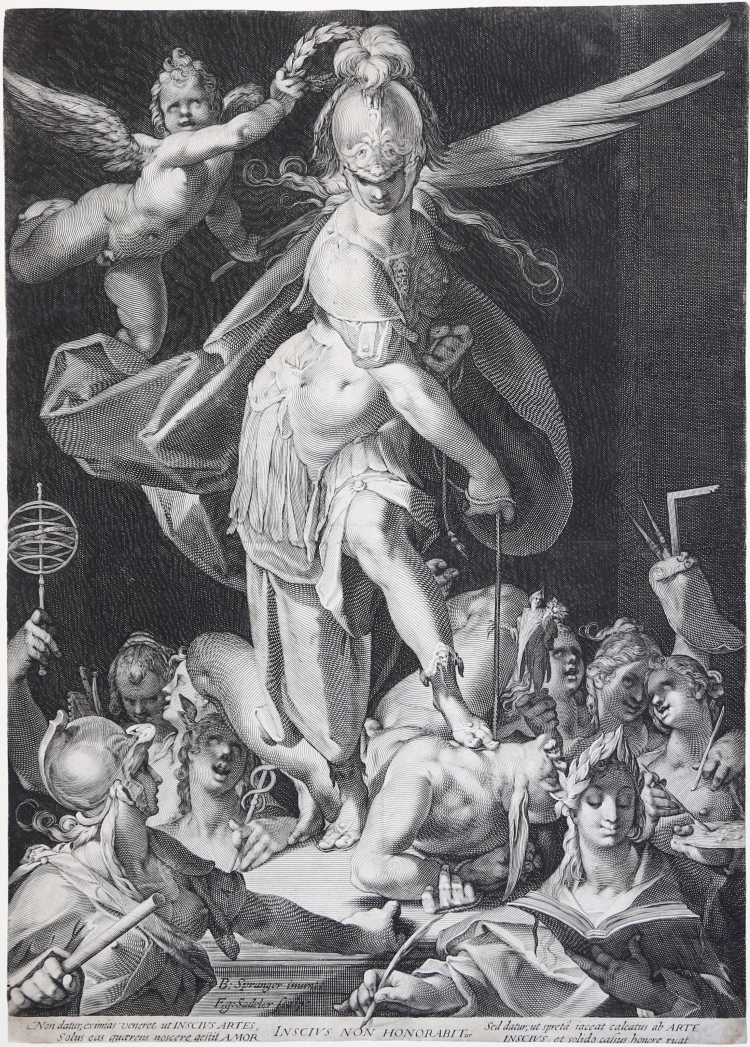



| Reference: | S40800 |
| Author | Aegidius II SADELER |
| Year: | 1600 ca. |
| Measures: | 351 x 491 mm |


| Reference: | S40800 |
| Author | Aegidius II SADELER |
| Year: | 1600 ca. |
| Measures: | 351 x 491 mm |
Engraving, 1600 circa, inscribed "B. Spranger invent. Fig. Sadeler sculp." in the plate, bottom centre. In margin below, four Latin lines in two columns “Non datur; eximas veneret, ut inscius artes, solus eas quaerens noscere, gestit amor…”, at centre: “Inscius non honorabitur”.
Magnificent proof, rich in tone, printed on contemporary laid paper, trimmed at the marginal line, perfectly executed restorations at the corners, traces of horizontal crease, otherwise in good condition.
After the painting by Bartholomäus Spranger, around 1596, in the Kunsthistorisches Museum, Wien
Wisdom is in the form of Minerva with one foot on ignorance, a man with donkey ears. A putto honors her with a laurel wreath. She has tied the hands of the man with a rope. Around them are seven personifications as a variation on the seven liberal arts: astronomy, music, geometry, painting, sculpture and rhetoric. Under the representation a four-line, Latin caption emphasizes that ignorant people are incapable of worshipping the arts.
Literature
Hollstein, XXI,115; Wurzbach 82.
Aegidius II SADELER (Anversa, 1570 circa - Praga, 1629)
|
Aegidius Sadeler or Aegidius Sadeler II (1570–1629) was a Flemish engraver who was principally active at the Prague court of Rudolf II, Holy Roman Emperor and his successors. Sadeler was born in Antwerp in the Sadeler family of print dealers and engravers. He was the son of Emmanuel de Sayeleer and the nephew of Aegidius I, Jan I en Raphael Sadeler. He was trained by his uncle Jan I and became a member of the Antwerp Guild of St. Luke in 1589. He was active in Munich the next year in 1590, in Rome in 1593, in Naples and then again in Munich in 1594–1597. From 1597 he settled in Prague where he became court engraver for Rudolf II and made engraved portraits of notables and engravings after artworks there, most notably paintings by Bartholomeus Spranger, Roelant Savery, Hans von Aachen, Giuseppe Arcimboldo, and sculptures by Giambologna and Adriaen de Vries. His early engravings were mostly faithful copies of works by Albrecht Dürer in the Imperial collection and copies of paintings by notable Italian painters such as Raphael, Tintoretto, Parmigianino, Barocci and Titian or by Northern painters who worked there, such as Paul Bril and Denys Calvaert. In Prague he also engraved portraits of the notables of Rudolf's court, and collaborated with Spranger, Joseph Heintz the Elder, Jacobus Typotius and his friend Anselmus Boece de Boodt (1550-1632), Rudolf II's gemologist and physician. After Rudolf II died he enjoyed the favour and protection of the two succeeding Emperors, Matthias and Ferdinand II. According to Michael Bryan, "He used the graver with a commanding facility, sometimes finishing his plates with surprising neatness, when the subject required it; at other times his burin is broad and bold. His plates are very numerous, representing historical subjects, portraits, landscapes, &c. some of them from his own designs, many of which are much esteemed, particularly his portraits, which are executed in an admirable style. Sadeler died in Prague in 1629. He had many pupils, including Wenzel Hollar and Joachim von Sandrart, who wrote his biography.
|
Aegidius II SADELER (Anversa, 1570 circa - Praga, 1629)
|
Aegidius Sadeler or Aegidius Sadeler II (1570–1629) was a Flemish engraver who was principally active at the Prague court of Rudolf II, Holy Roman Emperor and his successors. Sadeler was born in Antwerp in the Sadeler family of print dealers and engravers. He was the son of Emmanuel de Sayeleer and the nephew of Aegidius I, Jan I en Raphael Sadeler. He was trained by his uncle Jan I and became a member of the Antwerp Guild of St. Luke in 1589. He was active in Munich the next year in 1590, in Rome in 1593, in Naples and then again in Munich in 1594–1597. From 1597 he settled in Prague where he became court engraver for Rudolf II and made engraved portraits of notables and engravings after artworks there, most notably paintings by Bartholomeus Spranger, Roelant Savery, Hans von Aachen, Giuseppe Arcimboldo, and sculptures by Giambologna and Adriaen de Vries. His early engravings were mostly faithful copies of works by Albrecht Dürer in the Imperial collection and copies of paintings by notable Italian painters such as Raphael, Tintoretto, Parmigianino, Barocci and Titian or by Northern painters who worked there, such as Paul Bril and Denys Calvaert. In Prague he also engraved portraits of the notables of Rudolf's court, and collaborated with Spranger, Joseph Heintz the Elder, Jacobus Typotius and his friend Anselmus Boece de Boodt (1550-1632), Rudolf II's gemologist and physician. After Rudolf II died he enjoyed the favour and protection of the two succeeding Emperors, Matthias and Ferdinand II. According to Michael Bryan, "He used the graver with a commanding facility, sometimes finishing his plates with surprising neatness, when the subject required it; at other times his burin is broad and bold. His plates are very numerous, representing historical subjects, portraits, landscapes, &c. some of them from his own designs, many of which are much esteemed, particularly his portraits, which are executed in an admirable style. Sadeler died in Prague in 1629. He had many pupils, including Wenzel Hollar and Joachim von Sandrart, who wrote his biography.
|